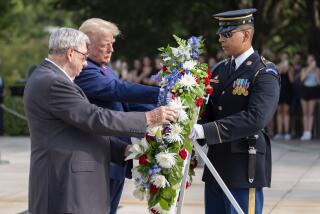Taking Care of Existential Graveyard : Veterans memorial: National Park Service ranger who picks up the notes, flags, photos and personal effects left each night at the wall, gains sense of involvement.
- Share via
WASHINGTON — The faded color snapshot was like thousands left at the Vietnam Veterans Memorial--two soldiers, arm in arm, grinning and relaxed as if they were millions of miles from a war zone.
But it was the degree of detail that caught Steve Black’s eye: The name of each soldier was visible on his uniform shirt.
Black, the National Park Service ranger who picks up the notes, flags, photos and personal effects left each night at the wall, started doing some research.
“I found out that they were from the same unit, that they were killed on the same day, and that they died on the day after the photo was taken. The date was still on the back,” Black said after completing his rounds on a recent foggy night. “One guy was black, the other guy was white, and it looked like they were best friends. It really sent a chill down my spine.
“That’s the one that really hit me.”
In a way, Black is a sexton in an existential graveyard, each night gathering the memorials widows leave for husbands, sisters for dead brothers, nieces and nephews for uncles they never knew, and increasingly, the messages total strangers leave to the 58,183 names on the black granite walls.
“Dear Soldier William D. Smith,” begins one letter Black found. “My father told me to write a note to you and leave it by your name. I know that I don’t know you and never met you, but I heard a lot about you. I want to thank you for fighting for my country and giving up your life for the country and the people. You are now in a better place with God. We all love you. Amen. Melissa Murphy.”
Black paused a moment, looking at the girl’s looping scrawl.
“People come mostly out of respect,” Black said. “They are settling feelings for themselves, or, like this one, a child is moved to write because of the pain she sees that the war has caused in others.”
More than 25 million people have visited the memorial since it opened 10 years ago, and more than 500,000 different mementos have been left. An exhibit of 500 items that includes combat boots, dog tags, military uniforms, and other, more personal messages, opened at the Smithsonian in late October.
On an average night, Black picks up from four to a dozen items left since another ranger did the same thing in midafternoon. He does his work quietly, trying not to intrude on people and their silent, nighttime communions at the wall.
Everything Black and other rangers pick up are catalogued at the site, then sent to a National Park Service warehouse in suburban Maryland. Flowers don’t go because of possible infestation. Flags are so plentiful that unless they include a personal message, they are donated to civic organizations such as the Boy Scouts or Veterans of Foreign Wars.
“This is a good part of my job,” said Black, 29. “You learn a lot about the war that way.”
He found a 4-inch brown teddy bear and a votive candle, held together with a piece of masking tape. A little farther toward the Lincoln Memorial, in front of panel W35, he picks up a homemade baseball card featuring a blond-haired, freckle-faced 6-year-old from Hilton Head, S.C. The boy wears a New York Yankees baseball cap and holds the bat with cocky defiance.
Someone’s nephew? Grandson? The child of a dead man’s best friend?
“We usually never know,” Black said. “These are quiet messages, really. They all seem to know that the person they leave them for would understand what they are all about.”
More to Read
Sign up for Essential California
The most important California stories and recommendations in your inbox every morning.
You may occasionally receive promotional content from the Los Angeles Times.










